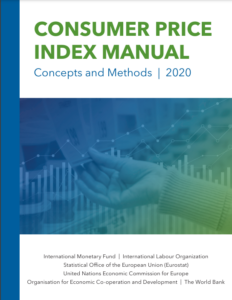Índice de contenidos
Introducción
Los índices de precios de consumo (IPC) miden las variaciones en el tiempo del nivel de precios de los bienes y servicios que consumen los hogares. En muchos países, se introdujeron originalmente para proporcionar una medida de los cambios en los costes de vida a los que se enfrentan los trabajadores, de modo que los aumentos salariales pudieran relacionarse con los niveles cambiantes de los precios. Sin embargo, a lo largo de los añosn el transcurso de los años, los IPC han ampliado su alcance. Hoy en día, se utilizan ampliamente como indicador macroeconómico de la inflación, una estadística clave para los gobiernos y los bancos centrales para la fijación de objetivos de inflación y para el seguimiento de la estabilidad de los precios. También se utilizan como deflactores en las cuentas nacionales. Con la globalización del comercio y la producción y la liberalización de los mercados, los gobiernos nacionales, los bancos centrales y las organizaciones internacionales conceden gran importancia a la calidad y la precisión de los IPC nacionales, así como a su comparabilidad internacional.
Catálogo de datos
| Indicador | Frecuencia | Base de datos | Asunto | Descargar (con etiquetas) | Descargar (con códigos) | Explorador de datos |
|---|---|---|---|---|---|---|
| Índice nacional de precios al consumidor (IPC) según CCIF (2017 = 100) | Anual | Precios, Costes y Conversiones de Moneda (PRICES) | Índices de precios al consumidor | .csv .dta .xlsx | .csv.gz | |
| Índice nacional de precios al consumidor (IPC) según CCIF (2017 = 100) | Trimestral | Estadísticas de la Fuerza Laboral a Corto Plazo (STLFS) | Índices de precios al consumidor | .csv .dta .xlsx | .csv.gz | |
| Índice nacional de precios al consumidor (IPC) según CCIF (2017 = 100) | Mensual | Estadísticas de la Fuerza Laboral a Corto Plazo (STLFS) | Índices de precios al consumidor | .csv .dta .xlsx | .csv.gz | |
| Índice nacional de precios al consumidor (IPC) según CCIF, porcentaje de variación con respecto al período anterior (%) | Trimestral | Estadísticas de la Fuerza Laboral a Corto Plazo (STLFS) | Índices de precios al consumidor | .csv .dta .xlsx | .csv.gz | |
| Índice nacional de precios al consumidor (IPC) según CCIF, porcentaje de variación con respecto al período anterior (%) | Mensual | Estadísticas de la Fuerza Laboral a Corto Plazo (STLFS) | Índices de precios al consumidor | .csv .dta .xlsx | .csv.gz | |
| Índice nacional de precios al consumidor (IPC) según CCIF, porcentaje de variación con respecto al año anterior (%) | Anual | Precios, Costes y Conversiones de Moneda (PRICES) | Índices de precios al consumidor | .csv .dta .xlsx | .csv.gz | |
| Índice nacional de precios al consumidor (IPC) según CCIF, porcentaje de variación con respecto al año anterior (%) | Trimestral | Estadísticas de la Fuerza Laboral a Corto Plazo (STLFS) | Índices de precios al consumidor | .csv .dta .xlsx | .csv.gz | |
| Índice nacional de precios al consumidor (IPC) según CCIF, porcentaje de variación con respecto al año anterior (%) | Mensual | Estadísticas de la Fuerza Laboral a Corto Plazo (STLFS) | Índices de precios al consumidor | .csv .dta .xlsx | .csv.gz | |
| Índice nacional de precios al consumidor (IPC), ponderaciones de los países (%) | Anual | Precios, Costes y Conversiones de Moneda (PRICES) | Índices de precios al consumidor | .csv .dta .xlsx | .csv.gz |
Métodos

Precios, costes y conversiones de divisas (base de datos PRICES)
Descripción concisa de conceptos y definiciones, usos, fuentes y limitaciones de las estadísticas sobre precios al consumo, costes laborales y factores de conversión monetaria.

Manual del Índice de Precios de Consumo: Conceptos y métodos | 2020
El manual ofrece una visión general de los métodos y las prácticas que los institutos nacionales de estadística deben tener en cuenta a la hora de tomar decisiones sobre cómo abordar los distintos problemas que plantea la elaboración de un índice de precios de consumo (IPC). Se trata de una actualización del manual del IPC de 2004.

COVID-19 Orientaciones para la recopilación de datos de estadísticas del trabajo: Índices de precios al consumo
La crisis del COVID-19 está afectando a las actividades de recopilación de datos de los institutos nacionales de estadística (INE) de todo el mundo, incluidos los índices de precios al consumo (IPC).

Manual del Índice de Precios de Consumo. Teoría y Práctica.
Este exhaustivo manual ofrece directrices para los institutos de estadística y otros organismos encargados de elaborar los IPC y explica en profundidad los métodos que se utilizan para calcular un IPC. También examina los conceptos y principios económicos y estadísticos subyacentes necesarios para tomar decisiones de manera eficiente y rentable y para apreciar todas las implicaciones de esas decisiones.

Manual de Índices de Precios de Inmuebles Residenciales (IPIR). Edición de 2013
Este manual ofrece directrices exhaustivas para la compilación de los IPIR y explica en profundidad los métodos y las mejores prácticas utilizados para calcular un IPIR. También examina los conceptos y principios económicos y estadísticos subyacentes que guían las opciones metodológicas en las que se basan los índices. El manual se dirige principalmente a los estadísticos oficiales encargados de elaborar RPPI, y proporciona un marco metodológico y práctico armonizado para todas las partes interesadas en su compilación. Escrito por destacados académicos en teoría de números índice y por reconocidos expertos en compilación de RPPI, este manual ha sido coordinado por Eurostat, con la colaboración de la OIT, el FMI, la OCDE, la CEPE y el Banco Mundial.

Fuentes y métodos Volumen 1: Índices de precios de consumo (2013)
El volumen 1 de Fuentes y métodos: Estadísticas laborales presenta descripciones metodológicas de las principales características de las series nacionales de índices de precios al consumo. La edición de 2003 es una versión revisada, ampliada y actualizada de la edición de 1992 y contiene descripciones para 169 países, zonas y territorios.






